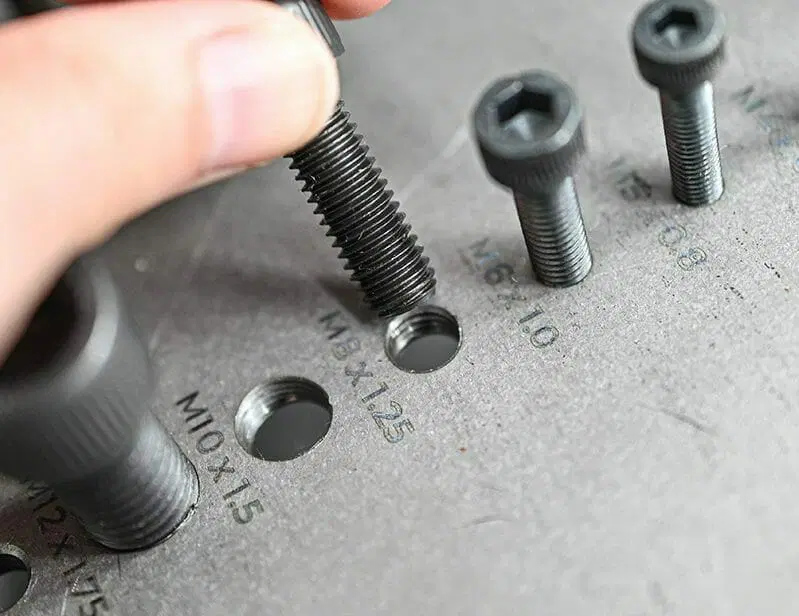Four Common Methods for Threading Holes in Sheet Metal
Threaded holes play a lead role in the assembly, maintenance, and overall product longevity for sheet metal fabrication. They enable secure connections between parts, allow for disassembly and reassembly when needed, and even contribute to cost-effective shipping by enabling flat-packed components that can be assembled on-site.
In many cases, choosing the right threading method means making sure those threads withstand real-world stress, vibration, and repeated use. Whether for electronics enclosures, industrial machinery, or aerospace components, understanding the different techniques for creating threads in metal can improve part performance and streamline fabrication processes.
Here’s a look at four of the most common methods fabricators use to create strong, reliable threaded connections in sheet metal.
1. Tapped Threads in Sheet Metal
For medium-to-thick sheet metal, tapping is one of the most straightforward and widely used methods to create internal threads. It involves cutting threads directly into a pre-drilled hole, allowing screws or bolts to engage securely without additional hardware.
This method is ideal when the metal is thick enough to support a strong, long-lasting thread. It’s commonly used in structural panels, machinery, and enclosures where parts must be securely fastened but also removable for maintenance.
How It Works:
A hole is drilled or punched to the correct diameter.
A thread tap is used to cut precise threads into the metal.
The hole is now ready for machine screws or bolts.
2. Threaded Inserts for Metal (PEM Inserts & Rivet Nuts)
When working with thin sheet metal, tapped threads are often not viable because there simply isn’t enough material for a durable, load-bearing connection. That’s where threaded inserts, like self-clinching fasteners (PEM inserts), rivet nuts, and weld nuts, come into play.
These inserts allow fabricators to add strong, reusable threads to thin or soft metals, improving overall strength and making assembly more reliable.
Types of Threaded Inserts:
Self-Clinching Inserts (PEM Fasteners) are pressed into place using force, permanently embedding into the metal without the need for welding or adhesives.
Rivet Nuts (Nutserts) expand and lock into place when installed, providing a removable threaded hole that works well with tubing and hollow sections.
Weld Nuts are permanently welded to the metal, offering the strongest connection but eliminating removability.
3. Extruded Holes with Threading (Formed Threads in Metal)
Extruded holes are a clever way to increase thread engagement depth without adding inserts. Instead of cutting threads into the metal directly, the material around the hole is stretched and pulled upward, creating a raised collar that provides an extra threading surface.
This technique is especially useful in thin-gauge materials where normal tapping wouldn’t provide enough grip. By increasing the available thread depth, extruded holes can handle more load and improve overall fastener retention.
How It Works:
A hole is drilled or punched slightly smaller than needed.
The surrounding material is stretched upward, forming a collar around the hole.
The hole is tapped to create internal threads.
4. Welded Studs & Nuts
For applications that demand permanent, high-strength fastening, welding a threaded stud or nut to the sheet metal is one of the most durable solutions available. Providing a secure, vibration-resistant attachment.
Stud welding is particularly valuable in high-vibration environments, such as automotive and industrial applications, where bolts could loosen over time. It also works well for thin sheet metal, since the weld provides all the necessary strength without relying on internal threads.
Choosing the Right Threading Method for Your Project
Each of these methods has distinct advantages depending on sheet metal thickness, strength requirements, ease of assembly, and project constraints. When selecting a threading solution, consider the following:
How thin is the material? Thin sheet metal often requires threaded inserts or extruded holes for a strong, reliable connection.
What kind of stress will the connection endure? Applications exposed to vibration, high loads, or repeated torque may require welded fasteners, self-clinching inserts, or extruded threads for added strength.
Are there space constraints? Certain methods, like extruded threads, are ideal for compact areas, whereas welded fasteners may require additional clearance for welding equipment.
What is the hardness of the material? Softer metals, like aluminum, may benefit from self-clinching inserts, while hardened materials may require direct tapping or welded solutions.
By evaluating these factors, fabricators can select the most effective threading method for their specific application.
Why Fabricators Trust HPM for Precision Threaded Holes
With decades of experience in precision sheet metal fabrication, HPM provides expert solutions for threading, fastening, and part assembly. Our capabilities include:
Advanced Tapping & Extrusion: Automated threading solutions for precise, repeatable results.
Threaded Insert Installation: Expert placement of PEM fasteners, rivet nuts, and weld nuts for high-strength applications.
Welded Studs & Fasteners: Durable, vibration-resistant solutions for industrial and structural applications.
High-Precision Hole Punching & Cutting: Accurate hole placement for reliable, long-lasting threaded connections.
Need expert advice on how to make threads in sheet metal for your next project? Explore our capabilities and request a quote from our team to get started today.




